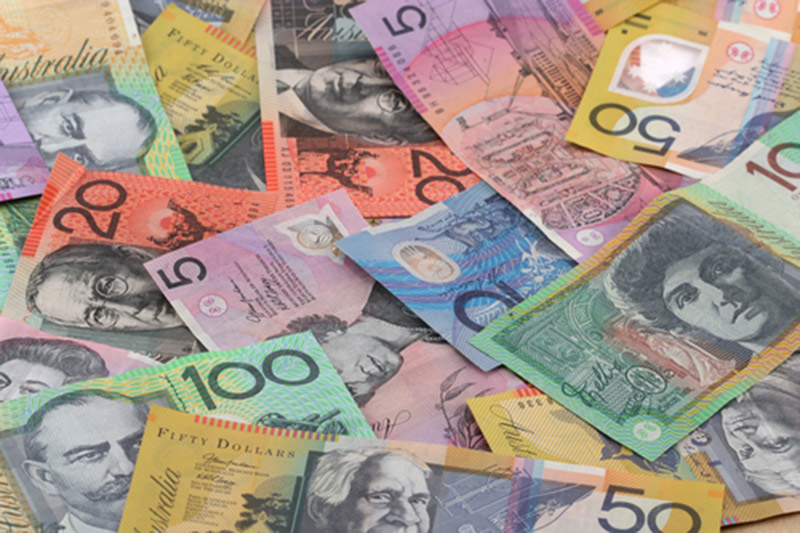Investing.com - The Australian dollar was up slightly in early Asia on Thursday ahead of manufacturing data in top export destination China with investors looking to see if easier central bank policies since November are flowing through the economy.
AUD/USD traded at 0.7877, up 0.04%, while USD/JPY changed hands at 121.22, down 0.09%.
In China, the May HSBC flash manufacturing PMI is due at 0945 local time (0145 GMT). The April reading was disappointing with HSBC PMI dropping to a one-year low of 48.9. The People's Bank of China has cut interest rates three times since November last year to keep the economy on track.
The U.S. dollar index, which measures the greenback’s strength against a trade-weighted basket of six major currencies, was up 0.02% to 95.68.
Overnight, the dollar remained broadly higher against a basket of other major currencies on Wednesday, as the previous session's upbeat U.S. data fuelled optimism over the strength of the economy and as markets eyed the Federal Reserve's upcoming policy statement.
The greenback strengthened after the U.S. Commerce Department said on Tuesday that the number of building permits issued last month increased by 10.1% last month to 1.143 million units from March's total of 1.038 million.
The report also showed that U.S. housing starts soared by 20.2% in April to hit 1.135 million units from March's total of 944,000 units, easily surpassing expectations for an increase of 9.9%.
The single currency weakened as Athens was still scrambling to reach an agreement with its international lenders over economic reforms they say must be implemented before the final €7.2 billion tranche of the country's €240 billion bailout is released.
Greece is due to make a €305 million payment to the International Monetary Fund on June 5, but will default if a deal is not reached by then.
The euro was also hit after senior European Central Bank policymaker Benoit Coeure said on Tuesday that the central bank is planning to speed up the pace of its bond-buying stimulus program before the summer in order to avoid the "notably lower market liquidity" in late July and August.
- English (UK)
- English (India)
- English (Canada)
- English (Australia)
- English (South Africa)
- English (Philippines)
- English (Nigeria)
- Deutsch
- Español (España)
- Español (México)
- Français
- Italiano
- Nederlands
- Português (Portugal)
- Polski
- Português (Brasil)
- Русский
- Türkçe
- العربية
- Ελληνικά
- Svenska
- Suomi
- עברית
- 日本語
- 한국어
- 简体中文
- 繁體中文
- Bahasa Indonesia
- Bahasa Melayu
- ไทย
- Tiếng Việt
- हिंदी
Forex - Aussie up slightly ahead of HSBC China PMI, PBOC effects eyed
Published 05/20/2015, 07:59 PM
Updated 05/20/2015, 08:01 PM
Forex - Aussie up slightly ahead of HSBC China PMI, PBOC effects eyed

Latest comments
Install Our App
Risk Disclosure: Trading in financial instruments and/or cryptocurrencies involves high risks including the risk of losing some, or all, of your investment amount, and may not be suitable for all investors. Prices of cryptocurrencies are extremely volatile and may be affected by external factors such as financial, regulatory or political events. Trading on margin increases the financial risks.
Before deciding to trade in financial instrument or cryptocurrencies you should be fully informed of the risks and costs associated with trading the financial markets, carefully consider your investment objectives, level of experience, and risk appetite, and seek professional advice where needed.
Fusion Media would like to remind you that the data contained in this website is not necessarily real-time nor accurate. The data and prices on the website are not necessarily provided by any market or exchange, but may be provided by market makers, and so prices may not be accurate and may differ from the actual price at any given market, meaning prices are indicative and not appropriate for trading purposes. Fusion Media and any provider of the data contained in this website will not accept liability for any loss or damage as a result of your trading, or your reliance on the information contained within this website.
It is prohibited to use, store, reproduce, display, modify, transmit or distribute the data contained in this website without the explicit prior written permission of Fusion Media and/or the data provider. All intellectual property rights are reserved by the providers and/or the exchange providing the data contained in this website.
Fusion Media may be compensated by the advertisers that appear on the website, based on your interaction with the advertisements or advertisers.
Before deciding to trade in financial instrument or cryptocurrencies you should be fully informed of the risks and costs associated with trading the financial markets, carefully consider your investment objectives, level of experience, and risk appetite, and seek professional advice where needed.
Fusion Media would like to remind you that the data contained in this website is not necessarily real-time nor accurate. The data and prices on the website are not necessarily provided by any market or exchange, but may be provided by market makers, and so prices may not be accurate and may differ from the actual price at any given market, meaning prices are indicative and not appropriate for trading purposes. Fusion Media and any provider of the data contained in this website will not accept liability for any loss or damage as a result of your trading, or your reliance on the information contained within this website.
It is prohibited to use, store, reproduce, display, modify, transmit or distribute the data contained in this website without the explicit prior written permission of Fusion Media and/or the data provider. All intellectual property rights are reserved by the providers and/or the exchange providing the data contained in this website.
Fusion Media may be compensated by the advertisers that appear on the website, based on your interaction with the advertisements or advertisers.
© 2007-2024 - Fusion Media Limited. All Rights Reserved.